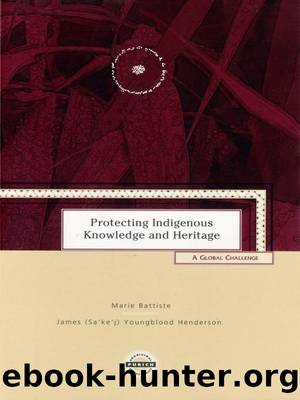Protecting Indigenous Knowledge and Heritage by Marie Battiste

Author:Marie Battiste
Language: eng
Format: epub
Tags: SOC005000, LAW051000, POL045000
Publisher: Purich Publishing Ltd.
Published: 2010-09-29T00:00:00+00:00
Communal Rights to Traditional Designs in Modern Artworks
An emerging complication in the protection of intellectual and cultural property is the incorporation of traditional art images and designs into âmodernâ artworks, by both Indigenous and non-Indigenous artists. Some Indigenous artists complain that their works are only taken seriously if they contain traditional motifs or media such as wood and feathers. Indeed, a group of American Indian artists who largely use Eurocentric media displayed their works at the Palais des Nations in Geneva in 1984 under the title No BeadsâNo Trinkets to make this point. Most works of individual Aboriginal artists will be protected under copyright acts, both internationally and nationally, if the artist can show that the work originated from the author and that it was original. Yet, the cultural traditions that lie behind these individual manifestations receive no protection at all and hence are open to abuse. Difficulties arise from the fact that a design is derived from traditional artistic practices dating back possibly millennia. Two important questions form the next discussion: Can such efforts be subject to protection as original work? And who could claim authorship and ownership of such works?
The use of traditional motifs in individual art may be viewed as undermining the integrity of the culture, particularly if these motifs are used by, a non-Indigenous artist. There has been widespread commercial exploitation of traditional designs in the international and national markets. These designs have been used, for example, on tea towels, T-shirts, sarongs, table mats, restaurant menus, postcards, souvenirs, wall hangings, posters, fashion items, towels, and carpets. It is against this background of deprivation and dislocation that any examination of the legal protection of communal rights to traditional motifs in modern artworks should take place.
When objects are associated with individual artists, they tend to be accorded greater value and are more easily given legal protection than if they are viewed as communal property. However, Indigenous peoples may view the individualâs role in art quite differently. For example, distinctive pottery has long been made and exported by Pueblo women in the United States and by Quichua women in Ecuador. In both cultures, pottersâ styles fit within recognizable traditional boundaries, but the images these women sculpt or paint are highly individualized. Hence, both group and individual interests need to be considered when protecting these productsâ artistic merit and commercial value.
The complexity of providing protection for designs is discussed by anthropologist Kenneth Maddock (1988) in connection with Aboriginal Australiansâ practice of body painting. Some designs are in widespread use, while others have recognized creators and their use is restricted to the initiated men who have purchased the right to wear them. The extent to which a particular motif can be used or reproduced is a matter of local customary law, as well as the history of the particular design and the agreement that was made between its creator and first owner. Maddock concludes that no one general rule can be formulated for all Aboriginal designs. What this demonstrates, moreover, is
Download
This site does not store any files on its server. We only index and link to content provided by other sites. Please contact the content providers to delete copyright contents if any and email us, we'll remove relevant links or contents immediately.
The Pirates of Somalia by Jay Bahadur(1567)
Political Theology by Carl Schmitt(1519)
The Holocaust: A New History by Laurence Rees(1464)
The Social Animal by David Brooks(1389)
A Practical Guide to International Arbitration in London by Hilary Heilbron(1369)
Restitution by Restitution(1354)
Pirates of Somalia by Jay Bahadur(1322)
Coercing Virtue by Robert H. Bork(1298)
The Nuremberg Interviews by Leon Goldensohn(1232)
Basic International Corporate Taxation by Sebastiano Garufi(1149)
A History Of Thailand by Baker Chris(1120)
The Global Commons by Susan J. Buck(1083)
International Trade and Business: Law, Policy and Ethics by Gabriël Moens & Peter Gillies(1080)
Asian Waters by Humphrey Hawksley(1078)
Blood Profits by Vanessa Neumann(1065)
Spring Fever: The Illusion of Islamic Democracy by McCarthy Andrew C(1058)
The Sovereignty of Human Rights by Macklem Patrick(1033)
The Nuremberg Trials: The Nazis and their Crimes Against Humanity by Roland Paul(1002)
Crimes Against Humanity: Historical Evolution and Contemporary Application by M. Cherif Bassiouni(980)
